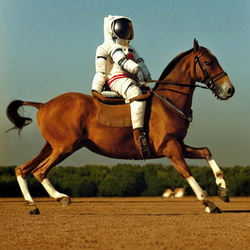Stable Diffusion
 An image generated by Stable Diffusion based on the text prompt "a photograph of an astronaut riding a horse" | |
| Original author(s) | Patrick Esser, Robin Rombach, et al. |
|---|---|
| Developer(s) | StabilityAI |
| Initial release | August 22, 2022 |
| Stable release | 1.4 (model)
/ August 22, 2022 |
| Repository | github |
| Written in | Python |
| Operating system | Any that support CUDA kernels |
| Type | Transformer language model |
| License | Creative ML OpenRAIL-M |
| Website | stability |
Stable Diffusion is a machine learning, text-to-image model developed by StabilityAI, in collaboration with EleutherAI and LAION,[1] to generate digital images from natural language descriptions. The model can be used for other tasks too, like generating image-to-image translations guided by a text prompt.[2]
It can run on most consumer hardware equipped with a modest GPU and was hailed by PC World as "the next killer app for your PC".[3]
Stability AI, the company behind Stable Diffusion, is in talks to raise up to one billion dollars in valuation as of September 2022.[4]
License
Unlike models like DALL-E, Stable Diffusion makes its source code available.[5] Its license prohibits certain harmful use cases.[6][7] Critics have raised concerns about AI ethics, stating that the model can be used to create deepfakes[8] and also questioning the legality of generating images with a model trained on a dataset containing copyrighted content without the consent of the original artists.[9]
Training
Stable Diffusion was trained on a subset of the LAION-Aesthetics V2 dataset.[10] It was trained using 256 Nvidia A100 GPUs at a cost of $600,000.[11]
See also
References
- ^ "Stable Diffusion Launch Announcement". Stability.Ai. Archived from the original on 2022-09-05. Retrieved 2022-09-06.
- ^ "Diffuse The Rest - a Hugging Face Space by huggingface". huggingface.co. Archived from the original on 2022-09-05. Retrieved 2022-09-05.
- ^ "The new killer app: Creating AI art will absolutely crush your PC". PCWorld. Archived from the original on 2022-08-31. Retrieved 2022-08-31.
- ^ Cai, Kenrick. "Startup Behind AI Image Generator Stable Diffusion Is In Talks To Raise At A Valuation Up To $1 Billion". Forbes. Retrieved 2022-09-10.
- ^ "Stable Diffusion Public Release". Stability.Ai. Archived from the original on 2022-08-30. Retrieved 2022-08-31.
- ^ "Ready or not, mass video deepfakes are coming". The Washington Post. Archived from the original on 2022-08-31. Retrieved 2022-08-31.
- ^ "License - a Hugging Face Space by CompVis". huggingface.co. Archived from the original on 2022-09-04. Retrieved 2022-09-05.
- ^ "Deepfakes for all: Uncensored AI art model prompts ethics questions". TechCrunch. Archived from the original on 2022-08-31. Retrieved 2022-08-31.
- ^ "AI Creating 'Art' Is An Ethical And Copyright Nightmare". Kotaku. Archived from the original on 2022-09-02. Retrieved 2022-09-02.
- ^ "LAION-Aesthetics | LAION". laion.ai. Archived from the original on 2022-08-26. Retrieved 2022-09-02.
- ^ Mostaque, Emad (August 28, 2022). "Cost of construction". Twitter. Archived from the original on 2022-09-06. Retrieved 2022-09-06.
